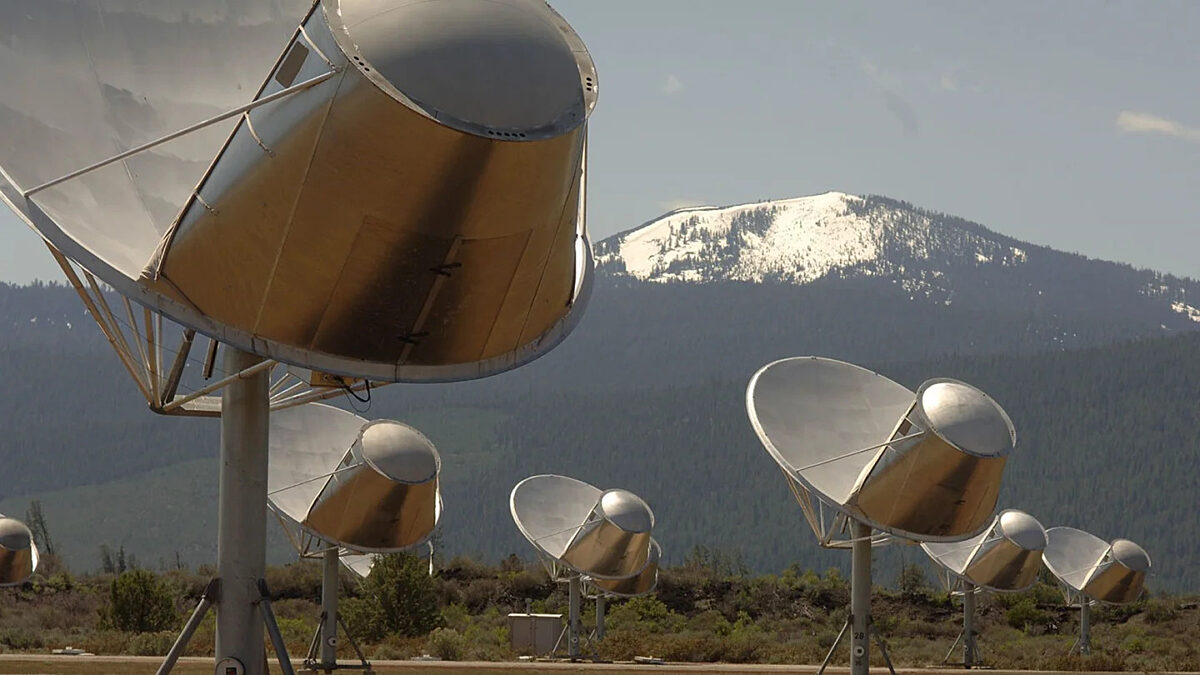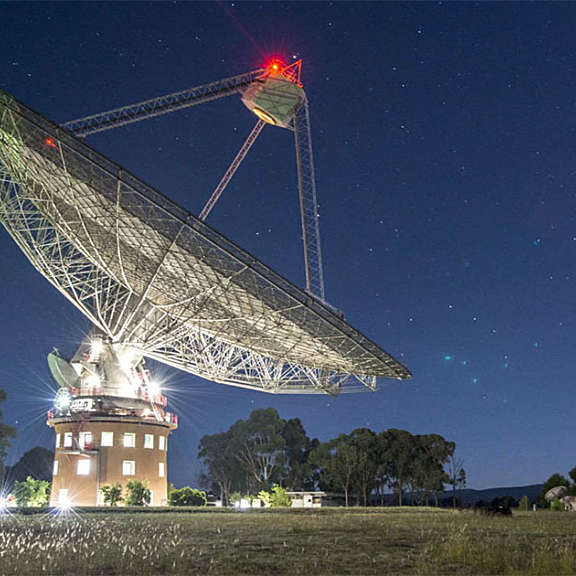Kate Howells • Oct 10, 2023
How do humans try to communicate with aliens?
Scanning for signals and sending out our own
The question of whether life exists beyond Earth has intrigued humans for centuries. The search for signs of alien life involves a variety of efforts, from the Perseverance rover collecting samples of Martian rocks to space telescopes peering at the atmospheres of distant exoplanets. It also includes the search for extraterrestrial intelligence, also known as SETI.
Most SETI projects are focused on looking for artificial or unusual signals coming from elsewhere in the Cosmos that might have been broadcast by technologically advanced life forms. Others involve sending out our own signals, showing that intelligent life exists here on Earth. And the potential implications of contact with an advanced alien species drives discussions not only based on science, but also ethics and policy.

Scanning for signs of extraterrestrial intelligence
With billions of trillions of planets and moons in the Universe, it’s very unlikely that Earth is the only home to intelligent life. So how do we go about looking for evidence of our cosmic peers?
Although many species on Earth are considered intelligent — dolphins, octopuses, and chimpanzees, for example — their sentience wouldn’t be detectable from afar. In the context of SETI, intelligence can only be identified by its outputs: technologies, industrial processes, communications methods, and so on.
Much of the search for extraterrestrial intelligence is based on the outputs that human intelligence creates, since those are the signs of technological advancement that we know best. Although alien civilizations could have super-advanced technologies beyond our wildest dreams, it’s also very likely that some things are universal. Electromagnetic communication is one such thing.
Humans use electromagnetic radiation to transmit information. From cell phones to television broadcasts, lasers to radar astronomy, our ability to use technology to manipulate the electromagnetic spectrum has served us very well as a species. We might assume, then, that other intelligent life forms would also have found this aspect of physics useful as well. It’s for this reason that much of SETI research involves scanning space for electromagnetic signals to try to identify patterns or transmissions that couldn’t be explained by natural phenomena. This includes listening for radio signals as well as looking for transmissions in the visible range of the electromagnetic spectrum, such as pulses of light.
Is There Anybody out There?
The Planetary Society has supported SETI, the search for extraterrestrial intelligence, practically since our founding in 1980. Learn the past, present, and future of SETI.
SETI is a large-scale effort that requires extensive collaboration. One Planetary Society-funded project, for example, involves searching a wide range of radio frequencies using the world’s largest steerable radio telescope, the 100 meter Green Bank Telescope in West Virginia. Their observations focus on 100 stars known to have planets around them, and due to the width of the radio telescope field of view, they pick up tens of thousands of additional stars and planetary systems. Citizen scientists from around the world then step in to help classify signals in the data to sort out the many sources of radio signals produced by intelligent life here on Earth and highlight the most promising signals in the data. Finally, professional SETI researchers revisit those promising signals to assess their potential as signs of intelligent life.
All of this takes hundreds of hours, and yet only represents a search of a tiny portion of space. The scale of the Universe makes the scope of SETI truly immense, which may be one reason why, so far, we haven’t found what we’re looking for.
Sending out signs of our existence
If intelligent aliens are out there, it’s fairly likely that they’re also conducting their own version of SETI. We are as likely to be detected by a civilization as advanced as our own as we are to detect them.
The signals that are most likely to be picked up by other life forms are those we send out deliberately for this purpose. All electromagnetic communication travels at the speed of light, but some signals make it farther than others, decreasing in intensity as they get farther from their source. The distance a transmission can reach depends on several factors, including the power of the transmitter and the frequency of the signal.
It’s a common science fiction idea that far-off aliens might pick up our stray television transmissions, but this isn’t likely to happen. Television signals are broadcast using fairly weak transmitters since they aren’t intended to go very far. The earliest television broadcasts have likely traveled beyond our Solar System by now, but they’re exceedingly weak by the time they reach interstellar space, and would be practically indistinguishable from the background noise of the Universe.
Some of our radar signals are likely to travel farther. Missile detection radar uses very strong transmitters, as do planetary radar systems like the now-defunct Arecibo Observatory, which used to use radar to detect near-Earth asteroids and other distant objects. It’s possible that intelligent aliens could pick up those radar signals and identify them as being of technological origin, provided those aliens weren’t much farther than the closest neighboring star system.
Humans have intentionally sent several strong signals into space with the intention of having them detected by extraterrestrial civilizations. These efforts are called METI (Messaging to Extraterrestrial Intelligence), CETI (Communication with Extraterrestrial Intelligence) messages, or forward/active SETI.

The Arecibo Message was one of the earliest and most famous METI attempts. A message was transmitted in 1974 from the Arecibo Observatory in Puerto Rico toward the M13 star cluster, including a binary-encoded image that conveyed basic information about Earth and humanity. Similarly, the Encounter 2001 project sent a message about our species and planet from the European Space Agency's EISCAT radar transmitter in Norway toward the North Star, Polaris. The message also included a specific set of messages and images from teenagers from around the world.
The Cosmic Call project sent two messages (one in 1999 and one in 2003) to nearby star systems using the RT-70 radio telescope in Ukraine. These messages included mathematical and scientific content as well as artistic elements. In 2013, the Lone Signal project invited the public to participate, collecting text messages to be sent in the direction of the Gliese 526 star system using the Jamesburg Earth Station radio dish in California.
Humans have also sent physical messages into space aboard spacecraft destined to travel far beyond our Solar System. NASA’s Pioneer 10 and Pioneer 11 spacecraft, both launched in the early 1970s, each carries a gold-anodized aluminum plaque with information about Earth's location and the spacecraft's origin. After passing through the Solar System to study the outer planets, these spacecraft carried on away from our Sun, meaning they could potentially travel through interstellar space forever, or perhaps until intercepted by another spacefaring species.
NASA’s followup Voyager mission took the concept a step further. The Voyager 1 and Voyager 2 spacecraft each carried a gold-plated phonograph record known as the Voyager Golden Record. These records were encoded with a wide variety of sounds and images representing Earth, including greetings in 55 languages, music, and scientific information. Because they reached greater speeds than the Pioneer spacecraft, the Voyager probes are now farther from the Sun, already in interstellar space.
Is contacting aliens a good idea?
The act of sending deliberate signals into space has generated debate within the scientific and ethical communities. One concern is that a very small group of people — sometimes just a few individuals — are given the responsibility of representing our entire species and planet. The inherent unfairness of this is considered a problem by some ethicists.
Another issue with METI is that we cannot possibly know the nature or intentions of an alien species that might find our signals. While it’s possible that we’d be discovered by a benevolent, advanced extraterrestrial civilization that could share secrets of interstellar travel, power generation, or any other world-changing technologies, it’s also possible that we’d be found by a civilization intent on conquering the galaxy and eradicating the existing creatures on life-sustaining planets. Because we can’t know the outcome of successful contact with intelligent extraterrestrial beings, some scientists are against METI, and there are space policy experts who have suggested that investing money and effort into METI efforts is unwise.
Ultimately, though, it’s possible that we’ll be discovered by aliens looking for life beyond their own planet whether we try or not. The possibility of life’s existence elsewhere in the Universe is one of the fundamental and unanswered mysteries about our reality, and it may not be up to us whether we solve that mystery. Regardless, the more we look and listen to the expanse beyond Earth, the more we will learn about ourselves and our place in the Cosmos.
Support our core enterprises
Your support powers our mission to explore worlds, find life, and defend Earth. You make all the difference when you make a gift. Give today!
Donate

 Explore Worlds
Explore Worlds Find Life
Find Life Defend Earth
Defend Earth



